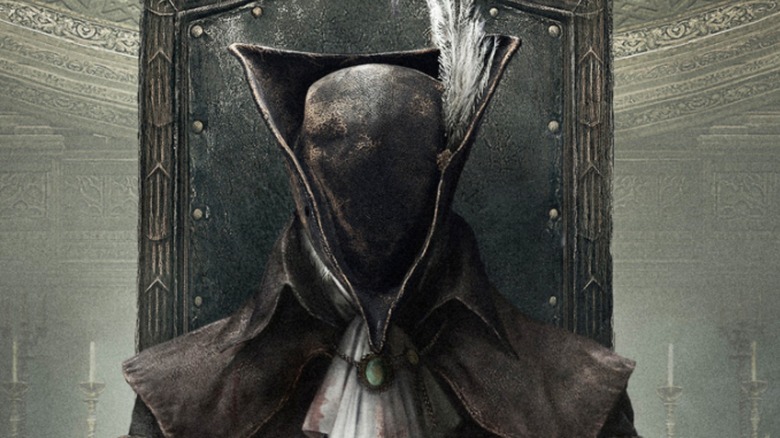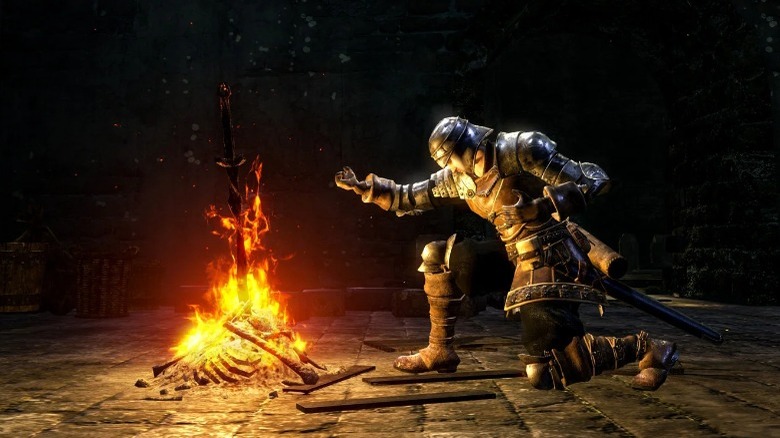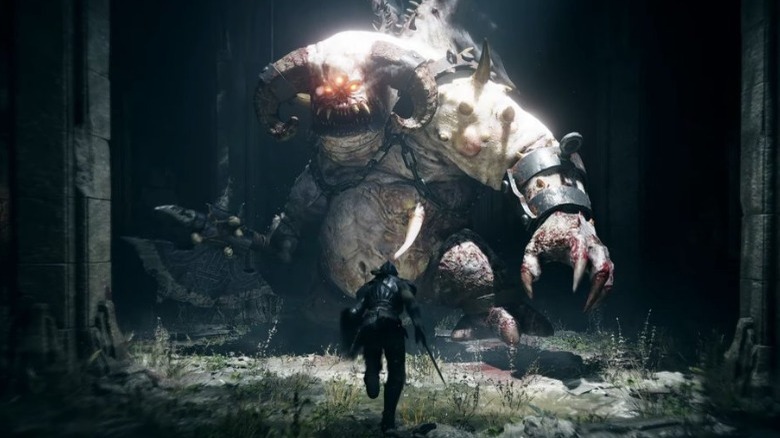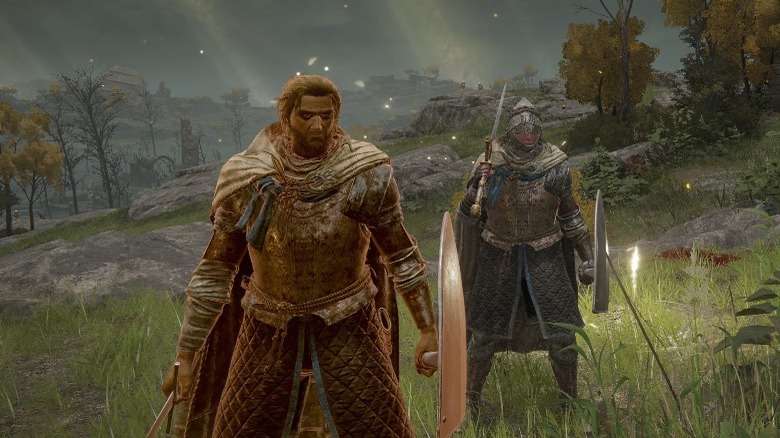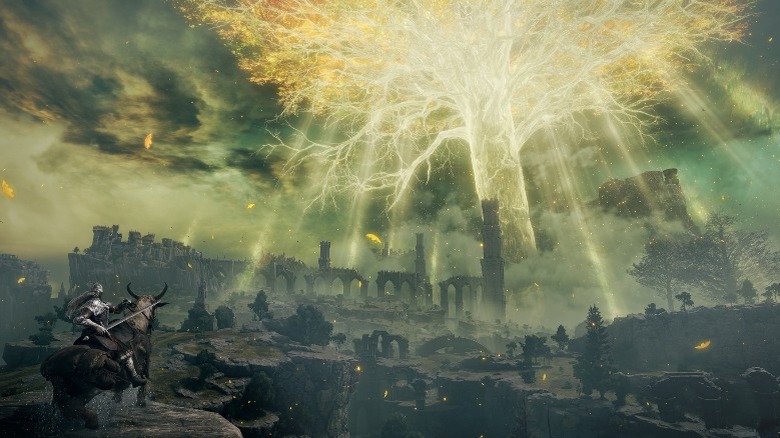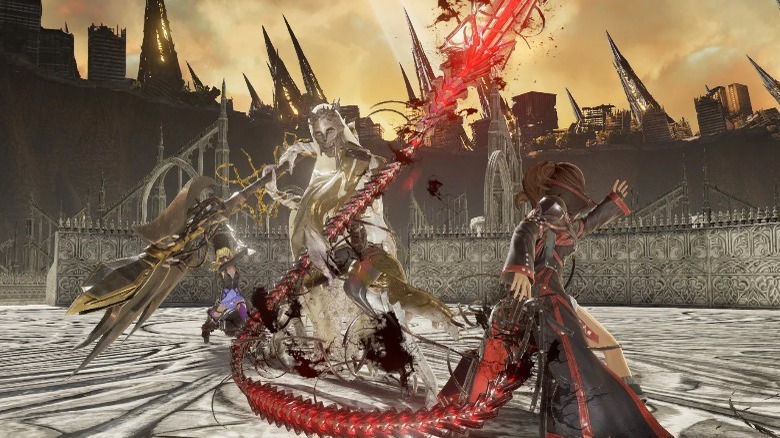The Soulsborne Video Game Genre Explained
There are several kinds of action RPGs out there. Some are lighthearted fun like "The Legend of Zelda: Breath of the Wild," some are serious metanarratives like "Nier: Automata," and some are more bombastic, cinematic experiences like "Mass Effect." Then there are games like those made by the legendary studio FromSoftware. These dark and atmospheric fantasy action RPGs are so unique that many have suggested they actually live within their own sub-genre. They were initially called "Souls" games after the "Demon's Souls" and "Dark Souls" series, but later came to be known as Soulsborne when "Bloodborne" released in 2015. This name stuck even after "Sekiro: Shadows Die Twice" came out in 2019.
A new game from the studio has proven more popular than anything else FromSoftware has made to date. "Elden Ring" has set a series of records in sales (surpassing the already impressive sales figures from "Sekiro") and the studio recently announced that it's looking to expand the IP into new formats. Many FromSoftware games have achieved popularity because of unique features that distinguish them from games typical of the genre. So, what is it that sets Soulsborne titles apart from other ARPGs?
Soulsborne leveling mechanics
Soulsborne games handle experience and leveling mechanics in a very interesting way. Units of experience have different names across the various franchises. They are called "Souls" in the "Dark Souls" series and "Runes" in "Elden Ring" for example, but they all work in a similar fashion. Experience points are primarily collected from downed enemies, as they are in most games, but they generally function as the games' primary currency as well. That means players buy and sell items using the same pool of points that they use to level up.
Another consistent trait in Soulsborne titles is that this experience/currency hybrid can be lost when the player dies. They then have the opportunity to recover their lost resource at the place where they died, but it will vanish if they die again before retrieving it. This encourages players to use these points quickly. They can be spent at stores operated by NPCs in order to buy equipment or at rest sites (Bonfires, Lamps, Sites of Grace, etc.) to level up character traits.
Soulsborne gameplay
It's no secret that the combat in Soulsborne games is hard. It's a point of pride for many fans of the genre that there is no easy mode, and therefore no way to complete any of these entries without overcoming the daunting challenges at their intended level of difficulty. A combination of hard-hitting enemies, depleting stamina, and limited healing means that gamers become intimately familiar with some variation of the "You're Dead" screen that appears each time their character meets their demise. This is all part of the experience, however. Soulsborne battles are difficult but never unfair. There is always a way to succeed.
The true joy of Soulsborne combat comes when a player learns from their mistakes and manages to master a tactic that allows them to overcome a given challenge. This can be seen against regular enemies in dungeons, but it's even more apparent in boss battles. Bosses are another element that helps define a Soulsborne and are one of the main reasons people come to these punishing titles. Each game has a lineup of individually designed bosses with unique move sets. The same tactics won't work on all of them, so players are constantly forced to learn new patterns, adjust, and come up with different strategies for beating them. This makes it all the more satisfying when they finally do.
Soulsborne multiplayer
Another unique feature that helps separate Soulsborne titles from other action RPGs is the way FromSoftware handles multiplayer mechanics. These games are designed with single-player campaigns at the forefront, but that doesn't mean players have to face these dark and intimidating worlds alone.
Soulsborne entries use item-based summoning mechanics to bring other players into the host's world. These items have different names depending on the setting, but they generally work the same. The assisting player uses an item to lay down a sign visible to other players (as long as they're in the same spot in the game world) which allows them to be summoned. The host-player then uses a consumable to summon the assisting player into their world.
While summoning party members can be helpful, it has some drawbacks as well. Enemy bosses will be buffed to compensate for the new ally, making them even more difficult than before. This also opens the host up to being invaded by other players who will attack them. Additionally, players can leave each other messages which can be spotted on the ground and read in-game. Be careful which messages to trust, however. Many of them offer advice that is less than helpful.
Soulsborne narratives
Unlike many action RPGs, narrative isn't generally considered one of the primary reasons players come to the Soulsborne genre. The atmosphere and design of the various settings does a lot towards immersing the player into the world. That doesn't mean the stories aren't there — or that they aren't complex or interesting — it's just that the storytelling is integrated into the environment and the player doesn't learn about it unless they choose to hunt it down.
Cutscenes are often quite brief and offer very little information. Players need to seek out codex entries, talk to NPC,s and read item descriptions to discover the various worlds FromSoftware has designed. Once they do, it becomes clear that these games are rich in history and lore. A common thread in Soulsborne games is that they are all set in areas that have endured some sort of calamity. There are usually the ruins of a great civilization that has collapsed and many of the enemies that the player faces are the twisted remains of that civilization's greatest heroes. Learning about the civilization that came before offers context for the world the player finds themselves in.
Soulsborne vs. Soulslike
Fans familiar with Soulsborne may have also heard the term "Soulslike." This designation refers to games developed by studios other than FromSoftware that were made after "Demon's Souls" released in 2009 using some or all of the traits found in Soulsborne games.
The label can be used quite loosely. "Hollow Knight" has been called a Soulslike (via Reddit) despite the fact that it's a 2D platformer set in a subterranean insect kingdom in addition to being an action RPG. Even though "Hollow Knight" doesn't look or move anything like a Soulsborne game, it still shares many of the same features. It's full of challenging boss battles, players lose all their money when they die but can retrieve it at the place where they fell, and it tells most of its story through an oppressive, post-cataclysmic environment.
The comparison is even more obvious in other titles. For example, "Code Vein" appears to have been designed using the Soulsborne playbook, mimicking virtually every aspect that defines the genre to the point that many refer to it as "Anime Dark Souls." It shares all the same tricks as "Hollow Knight" while also utilizing more Soulslike combat and multiplayer mechanics. It manages to have its own identity with a vampiric theme that offers several unique special abilities, but it's clear where much of its inspiration came from.

